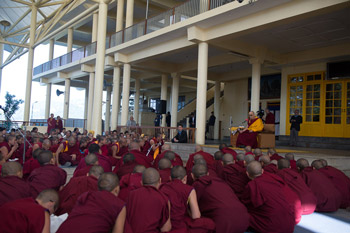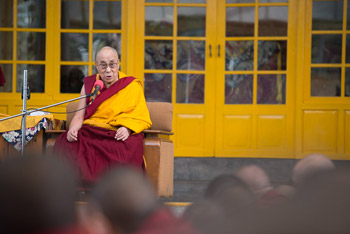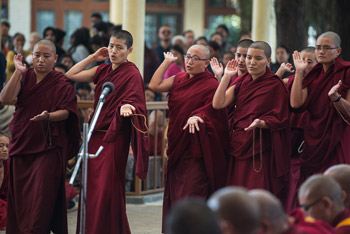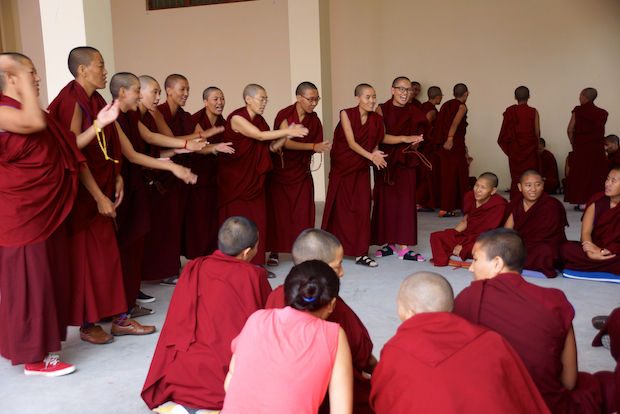On October 31 nuns from seven nunneries who were taking part in the annual inter-nunnery debate, the Jang Gonchoe, gathered at the main temple in Dharamsala and gave a special debate presentation to His Holiness the Dalai Lama.
This year marks the 20th anniversary of the nuns’ Jang Gonchoe debate session. Prior to 1995 the Jang Gonchoe was open only to monks, but now Tibetan Buddhist nuns are building their own strong tradition of debate.
According to a report on the event on the Dalai Lama’s website, His Holiness addressed the nuns and congratulated them twice, noting that there are nuns who have almost completed their study of Buddhist philosophy and who will take their final exams to qualify as Geshemas next year. The Geshema degree is the equivalent to a doctorate in Tibetan Buddhist studies.
His Holiness the Dalai Lama spoke at some length about the importance of reason and understanding in the Tibetan Buddhist tradition. He told the nuns, “This is the 21st century and we need to understand the Buddha’s teachings in the light of reason. When we teach, we need to do so on the basis of reason. I’ve met followers of the Pali tradition, monks from Thailand who are scrupulous in their observance of Vinaya [the monastic rules for monks and nuns]. I asked them whether they explain the Four Noble Truths according to reason or citing scriptural authority. They answered that they rely on the authority of scripture.”

Nuns from the annual Jang Gongchoe debate session listening to His Holiness the Dalai Lama. Photo/Tenzin Choejor/OHHDL
His Holiness said, “Nowadays, the Nalanda tradition of approaching the Buddha’s teachings with logic and reason is only found amongst Tibetans. It’s something precious we can be proud of and should strive to preserve.”
This year a total of 359 nuns from seven nunneries in India and Nepal took part in the month-long inter-nunnery debate which was held at Geden Choeling Nunnery, the oldest Tibetan nunnery in Dharamsala.
For the special presentation to His Holiness, 35 nuns from 5 nunneries in India (Geden Choeling, Dolma Ling, Jangchub Choeling, Jamyang Choeling and the Spiti Nuns’ Institute) and two in Nepal (Kopan Nunnery and Thukjey Choeling) took part.
Groups of seven nuns, one from each nunnery, engaged in a debate presentation in front of His Holiness. They debated topics such as the existence of past and future lives and how effects prove the existence of a cause.
His Holiness told the nuns that in the course of his 30 year dialogue with scientists, the scientists have come to appreciate Buddhism’s logical approach and its rich understanding of psychology. He also encouraged those at monastic institutions, such Namgyal Monastery, that formerly concentrated on rituals to study philosophy.
In a brief teaching, His Holiness said, “At the present time, in the ordinary world there is great advancement in the fields of science and technology. However, since we are distracted by the hustle and bustle of our busy lives, it is extremely important that those of us who follow the Buddha should have faith based on an understanding of his teaching. Therefore, we should examine it with an unbiased and inquisitive mind, analyzing it closely.”
He explained how, with this in mind, he had added nine masters of Nalanda to the eight traditionally referred to as the Six Ornaments and Two Supremes. Each of them had composed works that he wished to encourage others to read. He said that what distinguished the Nalanda masters was not only their use of reason and logic, but how they applied what they learned to the understanding of their own minds. He reserved particular appreciation for Shantarakshita who established the Nalanda tradition in Tibet.
Finally, His Holiness advised all those present to visualize the Buddha before them surrounded by the masters of Nalanda and others. He then led a short ceremony for generating the awakening mind based on the well-known four-line verse for taking refuge in the Three Jewels and generating the awakening mind. He concluded by saying, “Since we have Buddha nature we can achieve the Dharma Jewel within ourselves and so become a Sangha Jewel. And if we can help others, we should do so.”
The inter-nunnery debate has been supported since 1997 by the Tibetan Nuns Project. We are extremely grateful to all our donors who have helped make this possible. By supporting our Jang Gonchoe Endowment Fund and debate scholarships, we hope that the inter-nunnery debate can continue for many years to come and provide this important educational opportunity for the nuns.




Tashe Delek
This is so wonderful! The Dalai Lama is such a great supporter of the nuns! 🙂